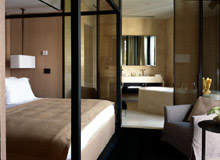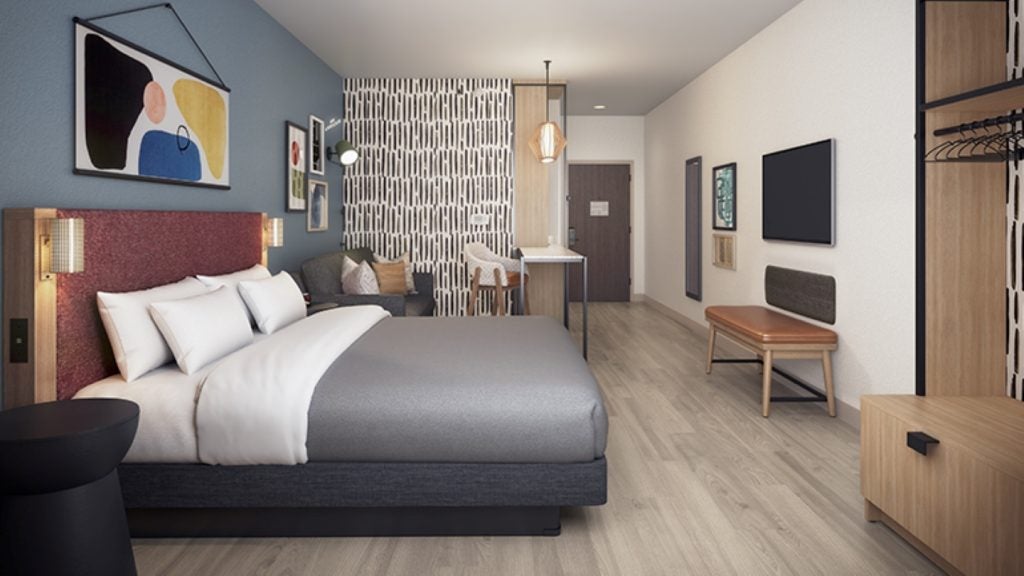
Collaborations between fashion houses and hotel chains may be on the increase, but such ventures are certainly not new.
Fashion doyenne Anoushka Hempel kicked off the trend for boutique hotels back in 1983, bringing an any-colour-as-long-as-it’s-white aesthetic to Blakes hotels in London and Amsterdam.
In 1990, Italian designer Krizia Mariuccia Mandelli, who had designed sports and evening-wear collections under the eponymous label Krizia, set up the luxurious K Club resort in the Antilles, whose design style was a combination of indigenous materials and imported Italian interior chic.
Donatella Versace has also taken her brand to far-flung climes, with Palazzo Versace opening in 2000 in Australia. Aptly for a fashion line famous for its unadulterated bling, it is located on the Gold Coast, and the vibe is pure Versace glam with shocking pink and gold the norm as far as colours are concerned.
Fellow Italian label Diesel has also taken its OTT aesthetic and transformed 30 suites at the Pelican Hotel on the Miami beachfront where room names include ‘Jesus Christ Megastar’ and ‘Best Whorehouse’!
See Also:
The Ferragamo family, famous in fashion circles for their beautiful leather wares, also owns four hotels, but the company has stuck close to its hometown of Florence.
How well do you really know your competitors?
Access the most comprehensive Company Profiles on the market, powered by GlobalData. Save hours of research. Gain competitive edge.

Thank you!
Your download email will arrive shortly
Not ready to buy yet? Download a free sample
We are confident about the unique quality of our Company Profiles. However, we want you to make the most beneficial decision for your business, so we offer a free sample that you can download by submitting the below form
By GlobalDataAs well as the Continentale with its enviable location near the Ponte Vecchio and the Lungamo across the River Arno, it has the Gallery Hotel Art, which oozes low-key, haute couture chic, with lots of neutral caramel-based colours and high-end hotel fixtures such as double sinks and floor to ceiling curtains surrounding the beds.
Like Krizia, it also has a resort-style offering: il Borro, a medieval village that has been converted into several apartments along with a grand palazzo.
LACROIX’S LABOUR OF LOVE
Christian Lacroix was inspired to move into the hotel business after moving to the hip Marais district of Paris.
There he spotted and subsequently fell in love with a quaint 17th century building, formerly a bakery. “I’d ask myself, ‘if it collapses, who’ll renovate it?’ he recalls. “It will become pitiful.”
Eventually having acquired a neighbouring property, Lacroix set about converting it into a 17-room boutique hotel called the Hotel du Petit Moulin.
“There were four floors in one building and three in the other and they were not all level,” explains Vincent Bastie, the principal architect for the project. “We built stairways on the second and third levels to link certain rooms to the corridors. No two rooms have the same volume and many have different ceiling heights.”
Lacroix’s idiosyncratic detailing is omnipresent in the hotel, from the dress motif wallpaper on the landings to the curious mix of materials, with concrete ceiling, brown fabric walls and slate bathroom in one of the guestrooms.
“This is the first time I’ve really seen a project in three dimensions,” he adds. “It may not be monumental, but it’s much more impressive for me than a suit, an evening gown or even a whole collection.”
Fashion designers who put their name to a hotel are clearly demonstrating some business nous as well.
It’s all about the marketer’s holy grail of maximising your branding potential; the K Club has its own Krizia boutique, while the Gallery Hotel Art is a stone’s throw from Florence’s exclusive shopping street, Via Tornabuoni, where, the Salvatore Ferragamo store is also located.
Received wisdom states that you shouldn’t stick exclusively to one product, and hotels are a perfect opportunity for fashion houses to extend their brands.
G WHIZZ
Of course what makes fashion folk so desirable for hoteliers is their design flair, and milliner Philip Treacy is no exception.
He has worked with architects and interior designers Douglas Wallace on Monogram Hotels’ flagship property, the g hotel, one of Ireland’s newest luxury hotels, situated in Galway.
He picked out a seashell motif, which has been replicated right across the project. “I want to entertain and surprise, as well as delight,” says Treacy of his design ethos.
Treacy himself designed the door handles and bedside lamps and commissioned artwork from fashion illustrator David Downton, while Colin Jennings of Douglas Wallace created the mirror-panelled walls and red crystal marble floor of Gerry’s Bar.
The advantages of working with Treacy were, says Monogram chief executive Mary McKeon: “that he had a clear vision of what he wanted to achieve. The same precision that he applies to the design of his hats, he applied to the g. People who wear Philip’s hats do so because they make them feel glamorous and thoroughly ‘dressed up’. Philip wanted a visit to the g to also be a glamorous experience, and there is no doubt that it is.”
BULGARI MAKES ITS MARK
Large hotel chains are getting in on the act too. Ritz Carlton, part of the Marriott group, has collaborated with exclusive jeweller Bulgari on two projects so far.
The first Bulgari Hotel, in a converted convent in Milan, features teak interiors, soundproofed doors and sumptuous bathrooms, and is the work of architect Antonio Citterio.
He also worked on Bulgari’s latest project, a resort on the southern tip of the Jimbaran Peninsula in Bali, which features an impressive 59 villas and an oceanfront spa. Here, Citterio’s penchant for understated clean lines meets natural Balinese materials, such as stones, wood finishes and handmade fabrics.
One has to wonder, though: is this marriage of fashion and hospitality a happy one or is there potential for estrangement?
On the one hand, there is the question of materials; fashionistas can get away with delicate fabrics on the catwalk, but the guest turnover in hotels means that is not always practical. Finishes and details may not stand up to the constant maintenance and a hotel interior that is worn and torn will do no one’s reputation any good.
Similarly, fashion’s emphasis on creating a certain attitude may be at the cost of other details. One fashion emporium charged with producing the hotel’s marketing material reportedly came up with a very glossy offering that omitted both the hotel’s address and reservations telephone number!
And yet sometimes input from outside the hospitality world can really make a difference to how a hotel operates, as Spanish footwear firm Camper showed when it opened Casa Camper last year.
Owned by the Fluxa family, Camper worked with Fernando Arat, founder of the furniture store Vincon, to ensure the furniture and fittings were given a luxury, contemporary feel.
The Barcelona-based operation features 25 rooms, each bedroom situated door to door with a lounge on the opposite side of the corridor.
Its brand values of relaxed comfort are everywhere; the bedrooms deliberately face away from the noise of the street and the Tentemple area offers an informal dining option in stylish surroundings.
There is also a vertical garden, which provides an al fresco retreat from the hustle and bustle of the neighbourhood. Camper has really tried to put itself in its guests’ shoes – no pun intended.
FUTURE PROJECTS
Giorgio Armani also wants a more personalised approach to his proposed hotel ventures in the Middle East and beyond.
“I cannot think of a more energising prospect than bringing my philosophy to a collection of hotels and resorts,” he enthuses.
Boosted by an investment of $1bn from EMAAR, a large Dubai-based property development firm, the Armani Hotels and Resorts brand has ambitious plans for seven hotels and three vacation resorts within the next decade, with a project comprising 175 rooms and 160 adjacent residential apartments in Dubai kicking things off in 2008.
Fashion hotels are now multinational operations. In November 2005, Rezidor SAS announced that it was linking up with Missoni for a series of hotel projects, beginning with confirmed locations in Edinburgh, Dubai and Kuwait.
Kurt Ritter, Rezidor’s president and CEO, says: ‘”he deal gives us the perfect brand to take our share of this fast-growing sector. Missoni is one of the few fashion brands that has an instantly recognisable look, and this essence fits perfectly with our objective to create a pure brand that is totally committed to quality and consistency in design and service.”
Vittorio Missoni, the company’s director, adds: “We are very protective of the business my family has built, and want to ensure that we never sacrifice the values of that business in the pursuit of short-term growth.”
The collaboration will also include Matteo Thun, the celebrated Milanese architect and industrial designer, and the hotels will reflect contemporary Italian style. Stylish bars, welcoming cucinas and an emphasis on spa pampering will be the order of the day.
The Kuwaiti project at the Symphony Complex will afford great views of the Arabian Gulf, with over 200 guestrooms and a fitness centre. Hotel Missoni Edinburgh, meanwhile, represents one of the city’s most high-profile new hotel developments, with a planned location on the famous Royal Mile at Victoria Terrace and George IV Bridge, and a total of 130 guestrooms. The Dubai project can be found on Palm Island and has its own private harbour.
These first three Hotel Missonis are due to open by 2008, with 30 more expected to open or start development over the following two years, including in target destinations such as St Petersburg, Paris and Frankfurt.
The branding lines have been blurring where fashion is concerned ever since Coco Chanel first put her name to perfume in the early 20th century. Since then, supermodels have opened fashion cafes, and you can get anything from snowboards to pet accessories with a designer label should you wish.
Brands such as Fendi have found that home accessories are a particularly lucrative product range. Missoni has followed this blueprint too, establishing its own highly regarded homeware range.
As Giorgio Armani puts it: “Today, more than ever before, fashion has expanded to encompass our way of life, not just how we dress but where we live, which restaurants we eat at, which car we drive, where we go on holiday and which hotels we stay in.”
Checking in has just become another part of the seamless brand experience, and with names like Armani, Rocha and Missoni involved, fashion hotels should be in vogue for many seasons to come.







